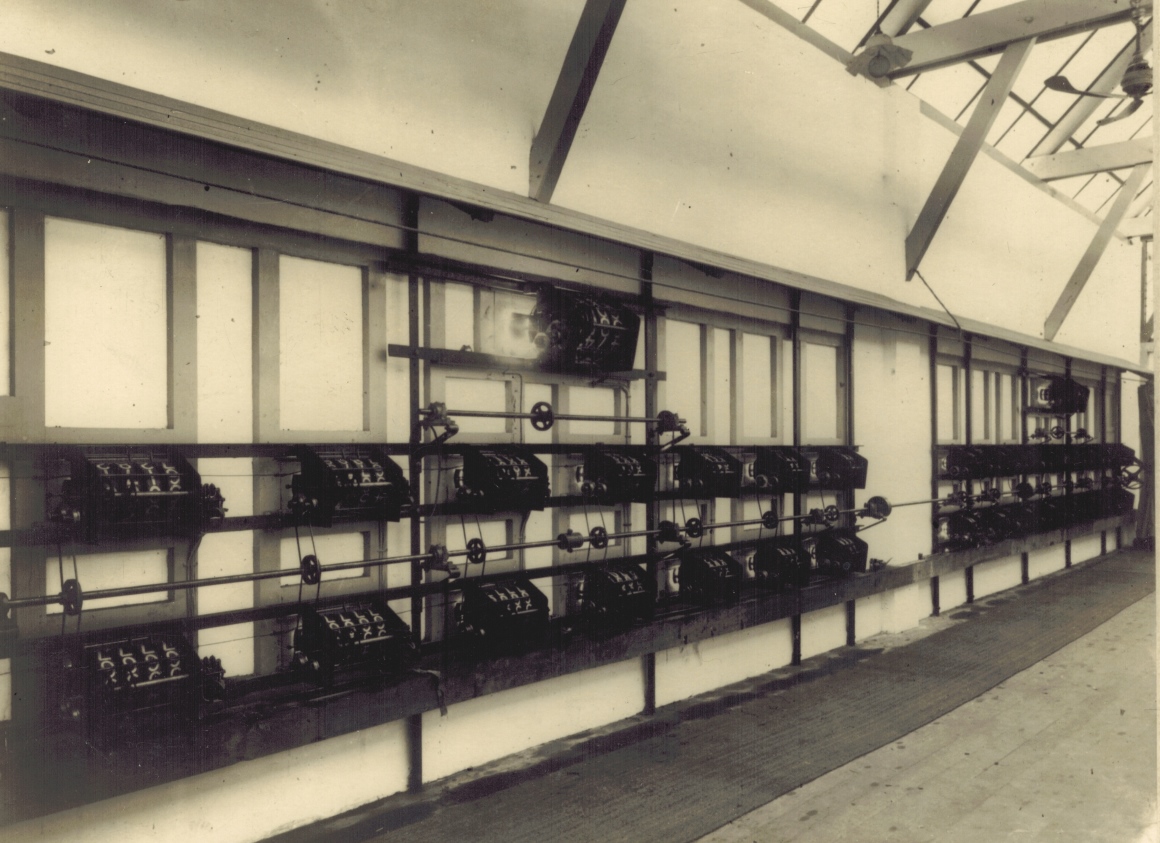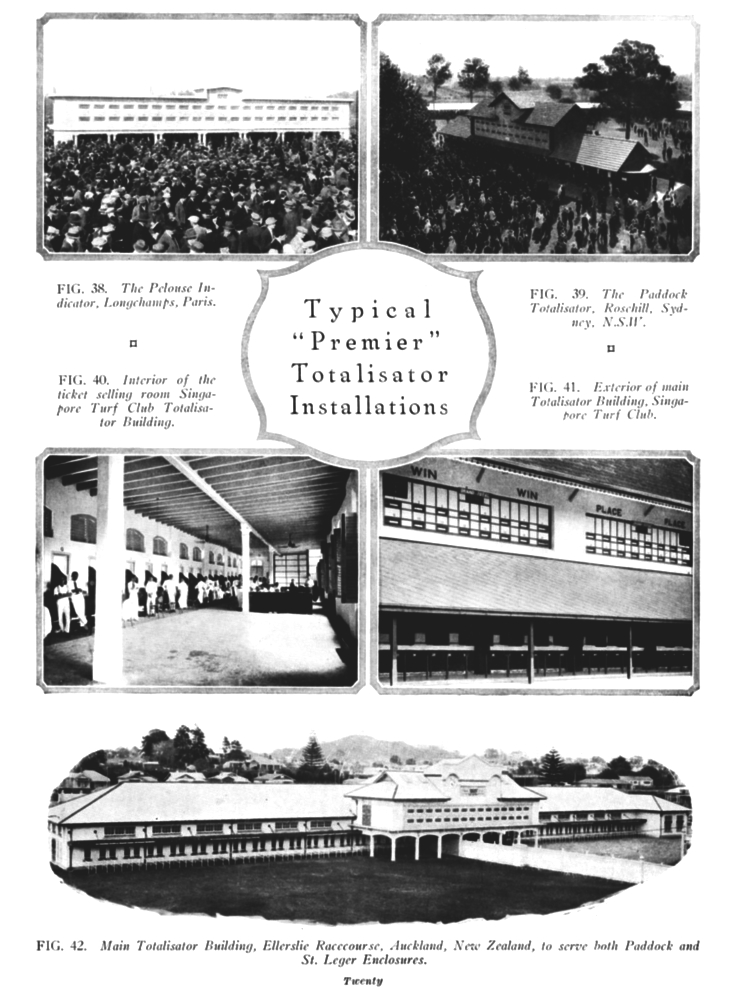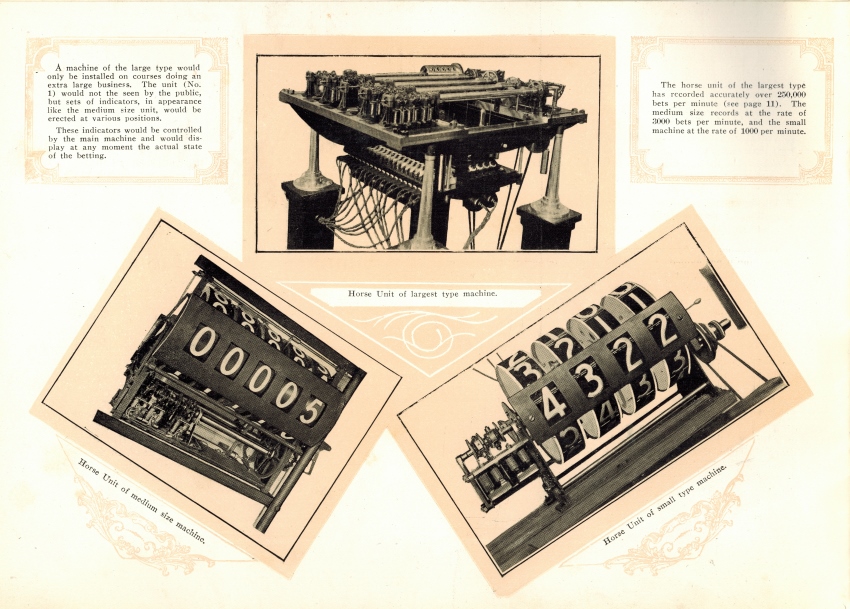This history page contains a photograph which is one of several belonging to the photo gallery pages which are part of several pages relating to the invention of the world's first automatic totalizator in 1913 and Automatic Totalisators Limited, the company founded in 1917 to develop, manufacture and export these systems.
The Singapore Machine Room
This is an image of a photograph that was taken at the Singapore Turf Club and shows the combined adder and counter wheel display units in the Julius Tote installed there in 1926 with 16 Ticket Issuing Machines. These counter wheel units with inbuilt adders display the tickets sold on each of the runners in a race. The solitary adder/display units sitting on top of each of the two banks of them display the grand total of all the units below them.
More after the image...

Click on the image to go back to the Photo Gallery
The photographer's stamp on this photograph reads: HALL & CO., Commercial Photographers, 20 Hunter Street, Sydney..
An Automatic Totalisators Limited product promotion document titled The PREMIER (JULIUS) AUTOMATIC TOTALISATOR, has a low resolution copy of a photograph of the outside of the Singapore totalisator building on page 20. An image of this page is shown below and the Singapore Totalisator Building external view image is in the middle row of images on the right hand side. The annotation of this external view image reads: FIG. 41. Exterior of main Totalisator Building Singapore Turf Club. The Singapore Machine room shown in the image above is on the first floor of the Totalisator Building behind the indicator on display in the image below labelled FIG 41. This image makes it clear that the right hand bank of adder/display units in the image above represent the Win pool and the left hand bank represents the Place pool. This is evident from the painted text on the external view of the Singapore Tote House below, WIN twice on top of the left investment indicator and PLACE twice on top of the right investment indicator. As the outside front view below has the WIN indicator on the left, the inside rear view of this indicator shown in the image above has the WIN indicator on the right. The Win and Place pool grand total adder/display units can be seen above and central to their respective runner adder/display units in the image above. These two grand total counters can be seen in the outside view image below where they look black for some reason. Either they are in the shade or perhaps they were not in place when the exterior view of the Singapore main totalisator photograph shown in the image below was taken. In that image it is also possible to make out some of the selling windows and queueing rails on the ground floor below the indicators.
On the left hand side of the photo of the exterior of the Singapore main Totalisator Building in the image below identified as FIG. 41, is a photo of the internal view of the ground floor level of the Singapore Totalisator Building. The annotation for this internal view of the ground floor level reads: FIG. 40. Interior of the ticket selling room Singapore Turf Club Totalisator Building. This selling room is where the sixteen J5 Ticket Issuing Machines are located which are connected to the adding units upstairs shown in the image above. I deduce that these TIMs are not directly connected to the adders rather that they are connected via a front end processor. The front end processor contains Time Division Multiplexers. I come to this conclusion by the observation that the adders only have two or three escapement wheels rather than 16, one for each of the TIMs, which would be required otherwise. The front end system is required to multiplex multiple ticket issuing machines onto each of the solenoids that control the escapement mechanisms that in turn control the rotation of the escapement wheels. The investment is represented as angular displacement of the output of the adding shafts. Looking at the nearest two adder/display units in the image above, the adder part of the unit can be discerned protruding out to the right from the lower right hand end of the counter wheels. In a higher resolution copy of this image it is clear that there are at least two escapement wheels with their associated escapement mechanisms and solenoids. It seems there is an outline of a third escapement wheel. If there are only two escapement wheels, then each will support 8 machines giving a total of 16. There is a larger higher resolution image of the Singapore Selling Room, similar to the one in the image below identified as FIG. 40, which follows the image at the top of this page in the photo gallery of this website. To view this higher quality image, click on the image above and select the image thumbnail following the thumbnail of the image above.
Page 20 PREMIER (JULIUS) AUTOMATIC TOTALISATOR

There is a full sized image of the page shown above in the photo gallery of this website. To view this full sized image, click on the image above and scroll down to the section titled Miscellaneous Images and select the image thumbnail with associated text starting This is a page extracted from a company document titled The PREMIER (JULIUS) AUTOMATIC TOTALISATOR .
In a company document titled Straight Betting, there is an image of the adder and counter wheel display unit on page 4, that is used in this Singapore installation and many of these are visible in the image at the top of this page. Page 4 of this document is shown in the image below. The annotation for this image reads Horse Unit of small type machine which is shown in the bottom right picture in page 4 below. In this close up view of a single adder and counter wheel display unit, it is fairly clear that the adding shaft seen protruding outside the left hand side of the counter wheel assembly, only has two escapement wheels. This resolves my previous speculation above regarding them having two or three escapement wheels when looking at these adder and counter wheel display units in the image at the top of the page. Note that in the bottom right picture in the image below we are looking at the front of the counter wheels and in the image at the top of this page we are seeing the rear of these adder and counter wheel display units.
There are pictures of another two horse units, or what in more recent times in the electromechanical era were called Adders, on page 4 shown below. One is another adder and counter wheel display unit annotated Horse Unit of medium size machine shown in the bottom left picture in the image below and the last is a large adder, which has separate display units, annotated Horse Unit of largest type machine shown in the top picture of the image below. The note inside the top left text box in the image below, to the left of the largest type machine image reads:
A machine of the large type would only be installed on courses doing an extra large business. The unit (No. 1) would not be seen by the public, but sets of indicators, in appearance like the medium size unit, would be erected at various positions.
These indicators would be controlled by the main machine and would display at any moment the actual state of the betting.
The note in the top right text box in the image below, on the right hand side of the largest type machine reads:
The horse unit of the largest type has recorded accurately over 250,000 bets per minute (see page 11). The medium size records at the rate of 3000 bets per minute, and the small machine at the rate of 1000 per minute.
You can view an image of the largest type machine on this website, which is identical to the one shown in page 4 of Straight Betting below. To view this, click on the image at the top of this page and scroll up to the Photo Gallery section titled Randwick Racecourse Sydney New South Wales, then scroll down again and select the image thumbnail with associated text starting This image shows an ornate early large system adder.
Page 4 Straight Betting

The two images above extracted from company booklets, are historic examples of artistic company product promotion in the early 1920s in the case of the lower image above and 1930 for the upper image. Low image resolution was probably normal back then.
Following is an extract from the ATL (Automatic Totalisators Limited) booklet titled The Computer Tote 1974 which relates to Singapore in the computer era, 48 years after the Julius Tote was installed. The totalisator business had changed considerably in the near half a century, going from 16 TIMs in 1926 to 256 in 1974 when this article was written! And now the extract:
The Singapore Turf Club and Automatic Totalisators Limited were associated with one another long before the computer tote was ever thought of. That association goes back as far as 1926, in the days of the T-model ford, when the club commissioned A.T.L to install its first Electro-mechanical Totalisator. As the popularity of racing in Singapore grew, so did the demands on the Club's totalisator operations and over the years additional equipment has been installed to keep its on-course betting service to the public continuously updated.
Last year, when the progressive Singapore Turf Club decided to go electronic and install a Totalisator System with a capacity to meet its rapidly growing turnover in betting it selected A.T.L's newest computer system.
The A.T.L Computer Totalisator System using two Digital Equipment Corporation PDP 11 Computers is flexible and capable of any required expansion to meet future growth.
The Singapore computer tote caters for standard betting pools, Win, Place and Forecast with a current capacity of 256 Ticket Issuing Machines.


